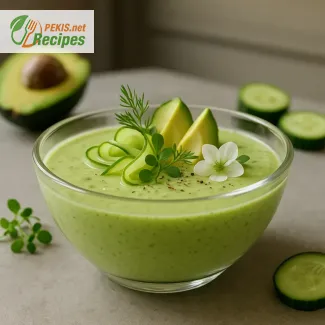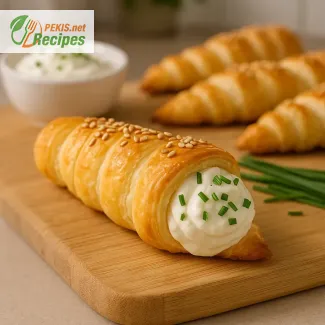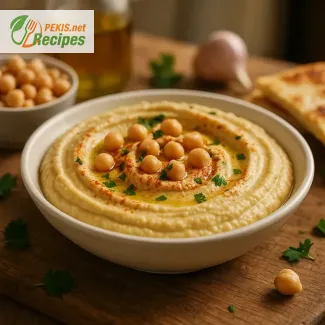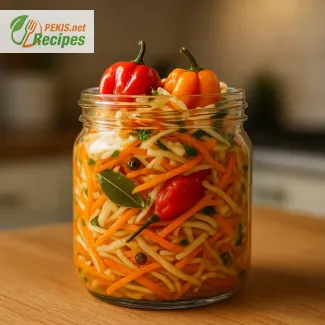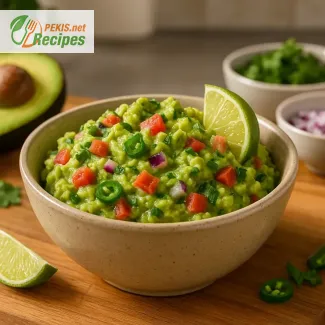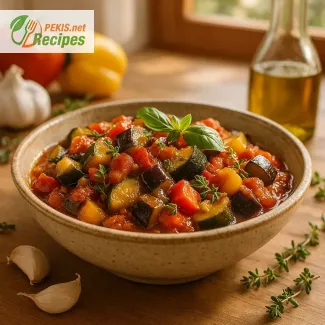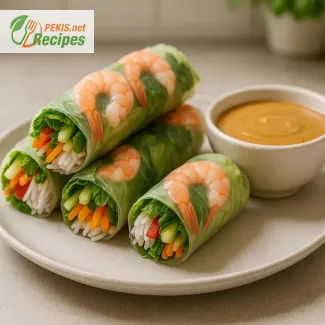
Irresistibly Fresh and Flavor-Packed: The Ultimate Homemade Spring Roll Experience
Discover the vibrant flavors and textures of fresh Vietnamese-style spring rolls
There's something undeniably satisfying about biting into a fresh spring roll—that crisp burst of vegetables, the delicate rice paper wrapping, and the rich, creamy contrast of peanut sauce. Often associated with Vietnamese cuisine, these light yet flavorful rolls are much more than just an appetizer—they're a celebration of texture, freshness, and balance. In recent years, fresh spring roll recipes have become a favorite among home cooks worldwide, thanks to their adaptability, healthful ingredients, and the opportunity they provide for culinary creativity.
Unlike their deep-fried counterpart, fresh spring rolls—also known as Vietnamese summer rolls or gỏi cuốn—are served cold and are made with translucent rice paper wrappers filled with a medley of crisp vegetables, herbs, vermicelli noodles, and often shrimp or tofu. What elevates them from a simple snack to an unforgettable dish is the homemade peanut dipping sauce, which adds depth, creaminess, and a slightly sweet, nutty complexity that perfectly complements the freshness of the rolls.
Whether you're preparing them as a light lunch, a starter for guests, or a vibrant centerpiece for a summer meal, homemade spring rolls with peanut sauce offer a deeply satisfying and refreshing experience. They’re not only visually stunning—thanks to the bright pops of carrot, cucumber, and lettuce visible through the rice paper—but also highly customizable, making them suitable for nearly any dietary preference.
Why fresh spring rolls are the ultimate no-cook meal
One of the most appealing aspects of a fresh spring roll recipe is that it requires no actual cooking—just some chopping, assembling, and dipping. This makes them ideal for hot days when turning on the stove is the last thing you want to do. The only element that needs softening is the rice paper, which becomes pliable in a quick bath of warm water. The result is a light, gluten-free wrap that’s soft yet slightly chewy, allowing the fresh ingredients to shine.
Fresh spring rolls are incredibly versatile. They can be made with a wide array of fillings, from traditional shrimp and vermicelli to vegetarian options featuring tofu, avocado, or mango. Herbs like mint, cilantro, and Thai basil add aromatic brightness, while the peanut sauce brings a creamy, savory contrast with its blend of peanut butter, soy sauce, garlic, lime, and a touch of sweetness.
A visual feast with every bite
Presentation matters, and these Vietnamese-style spring rolls offer a feast for the eyes as well as the palate. The translucent rice paper reveals layers of vivid vegetables and herbs, turning each roll into a mini work of art. When arranged on a platter next to a bowl of golden peanut dipping sauce, they look inviting and restaurant-quality—even if you’ve never rolled one before.
Rolling them is easier than it seems. Once you’ve softened the rice paper and laid out your ingredients, it’s just a matter of layering and gently folding. With a bit of practice, you’ll master the technique and find it both relaxing and rewarding. Making fresh spring rolls at home also allows you to adjust the flavors and textures to suit your preferences—whether you love crunchier veggies, more herbs, or extra protein.
Perfect for parties, healthy snacking, or meal prep
These spring rolls aren't just for dinner parties—they’re also perfect for meal prepping or quick weeknight meals. Because they’re eaten cold, they’re easy to pack for lunches or snacks on the go. Wrapped individually and kept chilled, they stay fresh and delicious for several hours. For gatherings, you can set up a spring roll station and let guests build their own combinations, turning it into a fun, interactive meal.
If you're looking for a way to increase your intake of raw vegetables without sacrificing flavor, spring rolls with peanut sauce are a delicious and satisfying solution. Their low-calorie, nutrient-dense ingredients make them a favorite among those looking to maintain a balanced and colorful diet, without giving up taste.
The secret is in the sauce
No spring roll experience is complete without the dipping sauce, and peanut sauce reigns supreme. Creamy, slightly sweet, and umami-rich, it brings everything together in the most indulgent way. Some recipes incorporate a bit of chili sauce for a kick, while others lean into the tanginess of lime juice or the saltiness of fish sauce or tamari. No matter your preference, the combination of textures and bold flavors creates a bite that’s both light and deeply satisfying.
This pairing of crisp spring rolls and savory peanut sauce is more than just a trend—it’s a culinary staple that continues to gain popularity across the globe. From health-conscious food lovers to seasoned cooks looking for something quick, fresh, and flavorful, it’s a go-to recipe that delivers every single time. Whether you're new to Asian-inspired cuisine or a longtime fan, this is one recipe that belongs in your regular rotation.
1. Prepare all ingredients:
Cook the vermicelli noodles according to package instructions. Drain and rinse with cold water. Prepare the vegetables by julienning the carrot, cucumber, and red bell pepper. Wash and dry the lettuce, mint, and cilantro.
2. Make the peanut sauce:
In a small mixing bowl, combine peanut butter, soy sauce, rice vinegar, maple syrup (or honey), lime juice, and minced garlic. Stir until smooth. Add warm water gradually until desired consistency is reached. For a spicy version, mix in chili sauce.
3. Soften the rice paper:
Fill a large shallow dish or plate with warm water. Dip one rice paper wrapper into the water for about 10–15 seconds until soft but still slightly firm. Place it flat on a clean surface or damp towel.
4. Assemble the spring rolls:
On the bottom third of the rice paper, place half a lettuce leaf. Add a small handful of vermicelli noodles (about 25 g), followed by carrot, cucumber, bell pepper, mint leaves, and cilantro. Place 3–4 shrimp halves above the vegetable stack. Fold the sides inward, then roll tightly from the bottom up, enclosing all the filling. Repeat with remaining wrappers.
5. Serve:
Cut the rolls in half on a diagonal if desired. Serve with the prepared peanut sauce for dipping.
Creative Twists and Tips to Elevate Your Homemade Spring Rolls
Explore ways to enhance flavor, nutrition, and technique in your spring roll preparation
Fresh spring rolls with peanut sauce are already a delightful and refreshing dish, but there’s always room for culinary creativity and refinement. With a few thoughtful adjustments, this traditional Vietnamese-style recipe can be tailored to meet different tastes, dietary goals, and even elevate the dish for more sophisticated presentations. From tweaking ingredients to improving rolling techniques and flavor profiles, this guide offers expert suggestions to help you make your spring rolls not only tastier, but also more nutritious and visually stunning.
Ingredient upgrades that make a difference
Add creamy avocado for richness
If you're looking to make your spring rolls more satisfying and nutrient-dense, consider adding slices of ripe avocado to the filling. Avocado adds a creamy texture that complements the crunch of fresh vegetables and the chewiness of rice noodles. It also provides healthy fats and a subtle buttery flavor, which enhances the overall mouthfeel and balance of the dish.
Boost umami with marinated tofu or mushrooms
For a more savory version, especially if making a vegetarian spring roll, marinate tofu or sliced shiitake mushrooms in soy sauce, sesame oil, and garlic before adding them to your rolls. This simple step can infuse the filling with a deeper umami flavor, making the rolls more flavorful even without shrimp or meat.
Introduce fruits for a fresh contrast
Adding julienned mango or pineapple provides a sweet and tangy contrast that pairs beautifully with the richness of the peanut sauce. These fruits add brightness and a touch of tropical flair, making your spring rolls perfect for summer gatherings or special occasions.
Homemade vs. store-bought: why DIY wins
Preparing spring rolls at home allows for greater control over ingredients, ensuring freshness and quality. Many store-bought versions contain preservatives, added sugars, and fillers, whereas homemade rolls can be made with organic vegetables, fresh herbs, and high-quality proteins. Additionally, the act of assembling spring rolls can be a fun and mindful cooking experience that engages the senses and brings people together.
Homemade peanut sauce is another major advantage. When made from scratch, it can be tailored to suit dietary needs—such as using natural peanut butter without added sugar, or substituting almond or sunflower seed butter for allergy-friendly versions. You can also adjust the sweetness, spice, and saltiness exactly to your liking, creating a truly customized dipping sauce.
Common mistakes to avoid
Over-soaking rice paper
One of the most frequent issues beginners face is over-soaking the rice paper, making it too soft and prone to tearing. Aim to dip the wrapper in warm water for just 10–15 seconds—it should still feel slightly firm when you begin wrapping. It will continue to soften as you work.
Overfilling the rolls
While it’s tempting to pack in as many ingredients as possible, overfilling leads to tearing and makes the rolls hard to seal. Stick to modest portions of each component and layer them neatly for better structure and presentation.
Rolling without drying the surface
Always use a slightly damp towel or surface to prevent the rice paper from sticking or sliding. If your surface is too wet or too dry, the paper can become sticky or brittle. Getting the right moisture balance helps ensure smoother rolling.
Healthier and lighter alternatives
Use brown rice vermicelli
To increase the fiber and nutrient content, substitute regular vermicelli noodles with brown rice vermicelli. It maintains the same texture but offers better nutritional value, particularly for those watching their blood sugar levels.
Swap shrimp for grilled tempeh
Tempeh is a fermented soy product rich in plant-based protein and probiotics. Lightly grilled tempeh adds a smoky, nutty flavor and makes your rolls more filling. It’s an excellent alternative for those seeking to reduce their meat intake while maintaining satisfaction and texture.
Reduce sodium without losing flavor
High sodium content often comes from soy sauce and dipping sauces. To reduce this, choose low-sodium soy sauce or tamari, and season your peanut sauce with fresh ingredients like lime juice, garlic, and a touch of maple syrup. The result is still flavorful, but more heart-friendly.
Small adjustments, big flavor impact
Toast your peanuts
If you’re using peanuts as a garnish or blending them into your sauce, consider toasting them first. Toasted peanuts bring out deeper, roasted flavors and improve the overall aroma of your sauce.
Add herbs inside and out
While mint and cilantro are common fillings, try incorporating Thai basil or perilla leaves for a more complex herbal profile. You can also garnish the finished rolls with additional herbs for both decoration and an aromatic boost.
Play with texture: crunchy and creamy layers
A good spring roll thrives on textural contrast. Balancing the crispness of vegetables with creamy elements like avocado or soft tofu creates a more satisfying bite. Even the sauce can be adjusted to include crushed peanuts for a bit of crunch in every dip.
Presentation and serving enhancements
Serving spring rolls on a cold platter with carved vegetables or edible flowers can enhance visual appeal for special events. Offer multiple sauces—like hoisin, soy-lime dip, or spicy chili garlic oil—to give diners a variety of flavor experiences.
Cutting the rolls at a diagonal angle not only makes them more attractive but also showcases the vibrant layers inside. When arranged thoughtfully on a serving tray, they become a centerpiece that reflects care, skill, and attention to detail.
Mindful eating and enjoyment
Fresh spring rolls are naturally portion-controlled and made for slow, mindful eating. They require dipping, chewing, and appreciating texture, which makes them perfect for a health-conscious lifestyle. Paired with the creamy, protein-rich peanut sauce, they strike a beautiful balance between indulgence and lightness.
By understanding the nuances of each ingredient and applying small but impactful techniques, anyone can take a traditional spring roll recipe and transform it into a gourmet, personalized experience. Whether you're preparing them for family dinners, dinner parties, or your own meal prep routine, these thoughtful improvements will elevate both flavor and satisfaction.
Allergens present:
- Peanuts (in sauce)
- Soy (in sauce)
- Shellfish (shrimp)
- Gluten-free (only if soy sauce is gluten-free)
Substitution tips for allergens and gluten:
- For peanut allergy, use almond butter or sunflower seed butter.
- For soy allergy, substitute coconut aminos for soy sauce.
- For shellfish allergy, replace shrimp with marinated tofu or grilled tempeh.
- To ensure gluten-free, use certified gluten-free soy sauce or tamari.
- Vitamin A: 2100 IU – supports vision and immune function
- Vitamin C: 45 mg – antioxidant, helps with iron absorption and skin health
- Vitamin K: 65 mcg – important for blood clotting and bone health
- Folate (B9): 60 mcg – essential for cell division and fetal development
- Potassium: 320 mg – supports nerve function and muscle contraction
- Iron: 2.1 mg – contributes to red blood cell production
- Magnesium: 50 mg – important for muscle and nerve function
- Calcium: 60 mg – supports bone health and muscle function
- Beta-carotene: 1800 mcg – converted to Vitamin A, fights oxidative stress
- Lutein + Zeaxanthin: 1200 mcg – supports eye health
- Polyphenols (from herbs, vegetables, and peanut butter): approx. 100 mg – protect against cell damage and inflammation
